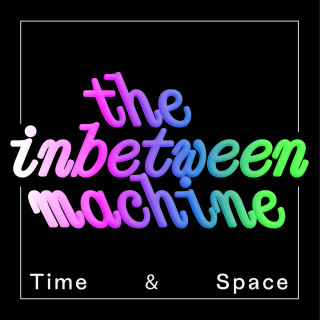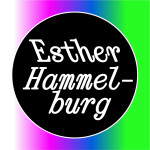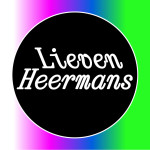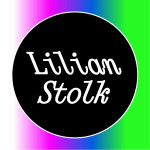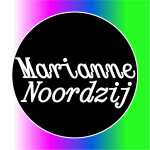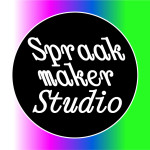The in-between
The Inbetween Machine
Welcome to The Inbetween Machine, the podcast that adds a
touch of excitement to your hybrid lifestyle. Chances are
you're tuning in while folding laundry, biking to a meeting or
winding down for the night. Our goal is simple: to enhance your
hybrid skills.
My name is Sekai Makoni, and I'm a mixed black woman with Afro
hair, a brown top and green trousers. I'm a cultural
programmer, workshop facilitator, podcaster and
artist. I'm your host, here to explore various aspects of
hybrid living in each episode. Joining me are the people who
created the Toolkit for the Inbetween and a special guest,
all sharing insights into the world of hybrid experiences.
The Toolkit for the Inbetween is a website. It's like a creative
toolbox for hybrid events brought to you by members from
three Dutch cultural institutions: The Hmm, a
platform and laboratory for internet and digital cultures;
affect lab, a research driven creative storytelling studio
focused on an inclusive future; and MU, a hybrid art house with
interdisciplinary exhibitions and innovative education.
In today's episode, we're delving into the role of time
and space in hybrid gatherings. So grab a cup of tea or coffee,
settle in, and let's explore the fascinating intersection of the
physical and digital in our lives. Welcome to The Inbetween
Machine.
The in-between.
When we're recording this, it's a calm December morning. It's
rainy outside and not as cold as we would like. And we're
downstairs in the basement of our Amsterdam podcast studio.
Today I'm joined by toolkit member, Lilian Stolk, who is the
director of The Hmm. Welcome, Lilian. Could you give us a
visual description of yourself?
Yes, I'm having brown hair and wearing it in a bun. I have a
light skin. And I'm wearing a woollen sweater, which if you
look closely has a print of a cake with the swirls and red
dots.
Beautiful. And we have a special guest here in the studio. Esther
Hammelburg. Could you give us a visual description of yourself
as well?
Sure, I have brown straight half long hair, white skin, brown
eyes, wearing a black sweater, and a black skirt with flowers
on it.
Beautiful. Welcome both of you.
Thank you.
So today's focus themes are time and space, to look more
specifically at how you can play with these themes during hybrid
events. You, Lillian, brought along two toolkit experiments,
The Hmm @ 4 Locations and Weaving Spaces. Lillian, could
you give us a short description of both toolkit experiments?
Yeah, sure. I start with The Hmm @ 4 Locations, because this was
I have one at home actually. It's a very fresh scent.
actually an event where the format was inspired by a
conversation I had with Esther. Esther was mentioning football
games as the perfect example of hybrid events because it can
take on different in different locations. You can experience it
in a football stadium, but you can also watch the game on the
big screen in a town square or watch it at home with friends.
And in all situations you still have the idea or the feeling
you're part of this live experiment or live event. And we
got triggered by this idea that, yeah, an event can have
different hubs. And we also wanted to see if we could take
it a bit further and even decentralise a programme even
more. Because in the football game example, still like the
most, yeah, the dominant part of the programme is taking place in
one location. And with The Hmm @ 4 Locations we actually had the
programme spread over four locations in four different
cities in the Netherlands, in Amsterdam, Utrecht, Eindhoven
and Rotterdam. It was an event with eight speakers. And in each
of the locations, there were two speakers physically present. And
the other speakers could be followed via livestream. And
there were different ways how we tried to stimulate connection
and exchange. And one aspect was that we created our own scent.
And we launched it during this event, I also brought it with
me. It's called The Hmmosphere and we created it together with
scent artist Cesar Majorana. And together we tried to translate,
we tried to make a scent for The Hmm. The Hmm is a platform for
internet culture, but how does the internet actually smell? So
yeah, we tried to... I can show you? Or show you...
Yeah, it's quite fresh. There's a lot of ozone in it, which is
also the smell that you, that appears when you're printing a
lot, for instance.
Smells a bit like warm cables.
Yeah, so we're spraying this scent in all the locations. So
yeah, there was a bit of a common, at least a common smell
in each location. And also people joining in from their own
house, joining in online, they also could order the scent and
spray it. So that was one thing that was similar in each
location. Then we also had that, like, all audiences were active
in the chat. And the chat was also presented on the stage. So
that's where everybody was having a conversation with each
other. They could also, if they had a question to one of the
speakers, they could ask it via the chat. Yeah, so that was also
a point where all the audience came together. And another
element that we added was that we did a wave at the end of the
event with all the locations. So we started in Amsterdam, then
Eindhoven, Utrecht and Rotterdam.
And how did you coordinate that? You're were just like...
Yeah, the audience could see themselves via the live stream.
So we, we, yeah, they responded to each other. Yeah, so that was
a bit of a short description of the @ 4 Locations event and then
for the Weaving Spaces event... Yeah, it's easy, of course, to
forget online audiences, because you don't see them. And it's
actually interesting to realise that everybody's joining from a
different, in a different situation. With The Hmm events,
we also often ask this question in the chat like, how are you
experiencing this event? Are you sitting in a kitchen table, at
your kitchen table? Or are you on the way, and we also for the
event Weaving Spaces - or the experiment Weaving Spaces - got
inspired by the ritual of check-in moments, where you
start a meeting with quickly sharing a personal like
situation you're in or what is also forming your experience, I
think. This together with the habit of knitting and weaving to
come together and share stories, led to the Weaving Spaces
experiment where we start an event with some questions that
we asked the audience. Can be questions from what surface is
underneath your foot at the moment, to how do you feel at
the moment? People answer that via a special web app that we
developed and after answering all the questions, the answers
are translated to abstract and less abstract data
visualisations and we also have a shared pixel drawing that they
made. And people can see their personal pattern that they
created after answering the questions, but we, as the event
organisers, we see a pattern appear that combines all the
answers and it's actually a pattern for a scarf that we
knit. I also brought some experiments. This is a scarf
that we printed for the The Hmm @ CBK Zuidoost. So here you see
the pixel drawing that the visitors made together, everyone
can put five pixels in the canvas here. Also the little
emotes, that was the most chosen emote of how people do feel at
this event, and here, oh yeah, how people are describing their
feeling after the event or the experience of the event? Is it
hectic? Was it lonely? Exciting? And what is it, it's a bit
difficult to read... interesting. And then it's, it's
stated like the most chosen option is the first one. And
then the last, the lonely one is the last chosen option. So
that's, that's good. And it's also having the date and the
title of the event.
I love it, and did people get to get a copy of the scarf?
Yeah, that we didn't develop yet but we want to. And I think the,
yeah, also the idea of that you create something together is
also making, yeah, giving a bit of bonding between the different
audiences. Yeah, so, and indeed, if you can then also order the
scarf and wear it yourself it's, yeah, adding to that idea.
I really love, like the way you're describing all of the
events, it feels like there's a kind of, a playfulness to it,
like the scent or the scarf. And even, in fact, like the
reference to football, right, watching it in person or on a
screen, and then you kind of create a scarf, which also feels
in some ways, like a reference to football.
Oh, yeah, I didn't think about that.
But I suppose I wonder what play and what, what role, like play
or humour or lightness has in your approach to these hybrid
events?
Yeah. Yeah, that's really important. I think also, content
wise, sometimes the topics are quite serious that we discuss
and if we put a lot of humour and playfulness in it, it's also
easier to digest. And I think with these hybrid events, it's
often... Yeah, we don't see so many fun experiments with hybrid
events, I think. It's often... people place a camera in space
and it's just a livestream. It's also a very passive experience,
like it's more becoming a TV broadcast. And I think, the most
important element of an event is that it is interactive, and
you're part of something. So I think adding the playfulness in
it is also contributing to that. Otherwise, we could make a
podcast of the event.
And what were people's reactions like after the event? Like oh,
this is so cool, there's a scent or I got a scarf. Like what did
people say who attended?
Yeah, they love it.
Yeah, yeah. Yeah.
I was a visitor, at one of the four locations and of some other
events. Yeah. So I bought the scent. I have it in my toilet at
home.
It's still there. Yeah, I really like it. It's really, I really
[laughter]
like the idea of using the senses and turning something
Like a memento. Brilliant. Thank you so much. And now we're going
that you're studying into different senses. So the scent
turning the internet into a smell. Yeah, I really liked the
notion, it broadens your scope, your way of thinking about how
the internet works, or what this means to the world. And it's a
nice artefact to have in your home.
to hear about a historical case study. So let's take a listen.
For this case study interlude, we want to share The World in 24
Hours by Robert Adrien. Transporting ourselves to the
year 1982, we find EUnet making its debut, marking the early
days of the European internet. Back then a realm mostly
reserved for scientists and researchers. Amidst this
backdrop, Robert Adrian introduces The World in 24 Hours
at the Ars Electronica Festival on September 27th. The project
is a telecommunication venture linking Linz, the host city of
the festival, with 15 cities worldwide. Each city was given a
specific time slot based on its timezone. From midday on
September 27th, to midday on September 28th, artistic groups
in each city connected with Adrian's team in Linz through a
variety of channels: computer terminals, telephones, fax, and
slow scan TV. The team in Linz contacted each location at 12
o'clock in their respective timezone. They then had one hour
to exchange material with the Linz team. Adrian envisioned the
project as setting a precedent for using telecommunication
networks in global artistic collaboration. The deliberate
choice of accessible mediums encouraged widespread
participation. The World in 24 Hours embodied mid-deep
hybridity, utilising diverse telecommunication methods to
connect artists globally in real time. Linz acted as a central
hub, facilitating collaboration despite the physical distance.
Although remote teams weren't directly connected, their
participation wove them into the 24 hour narrative, fostering a
sense of connection among participants. This
telecommunication endeavour wasn't just about technology, it
was also a human story. As the clock ticked, a shared creative
space emerged, transcending physical boundaries. The
artworks became more than conduits, they transformed into
vessels for shared creativity, bringing tangible artworks to
life in Linz. In the quiet dance of global connectivity, The
World in 24 Hours stands as a testament to the potential of
technology, reminding us that even in the vastness of
cyberspace, the heartbeat of human creativity remains
steadfast.
Esther Hammelburg is an expert on live experiences and hybrid
events. She claims that every event is in fact hybrid. We are
always in both physical and media environment at the same
time. She drew this conclusion from her PhD research, which
consisted of extensive fieldwork, speaking to 379
people, and gathering large datasets from social media
platforms, with which she shows how media use shaped the way we
experience being there live. Welcome, Esther.
Thank you very much.
So I was wondering: Is recording this podcast today also a hybrid
experience for you?
I think, yeah, every experience is hybrid. I think for us, for
us itself it's less hybrid in the sense that we're very
focused at what we're doing at this moment. We are not, our
voices are going to be in a lot of different media environments
afterwards. There's other people on the other side of the wall,
looking at us and listening to us. So we're aware of that. So
in that sense, you might call it hybrid. But I think it's more a
hybrid experience for the listener, because you'll listen
to this, as you said, in your introduction, perhaps when
you're in bed before sleep, or biking somewhere or on the train
or making dinner. And I believe that experiences differ also,
because these physical environments shape the way you
experience something. So for the listener, for sure, it's a very-
I think podcasts is one of the most hybrid experiences
actually, because we move along the physical world, while
listening to this media text.
Brilliant. So according to your research, we are here together
now is the crux of every event. And maybe we can unravel this
for hybrid events. And the here for an onsite event is the event
space. But maybe it includes also the travel to an event
space. For online visitors, the here is their computer, and also
the room where they are watching from. So what does space
contribute to an event? And how can we utilise this for a hybrid
experience?
Yeah, yeah, so in my PhD research, I studied liveness.
And said: a live experience makes- is being here, now,
together. So it's the space, the time and a social context. And
for space, what I studied was people who were at events, so
often festivals that were organised in a physical space,
but also, for instance, the Dutch fundraiser Serious
Request, which is a multimedia or a cross-medial format, which
has a studio where people can go to on a town square, but it's
also a radio programme. It's also life on television, it's a
live stream. So that is very, has very different spaces and
places to experience the event in. And what I noticed is that
visitors, even though they might be physically there at a
festival, they are also at the same time in various media
environment. So you are also on Instagram, for instance, I've
spoken to people who... one of my events that I researched was
the Pride in Amsterdam. I've spoken to people who were on a
boat in the Canal Parade, which is the central event of the
Pride so you would say that's the most there you can be,
saying that if they wouldn't have any photograph or social
media posts from that, they would feel less there. So being
there on Instagram or on a photo even in your own phone or
printed or on your roll or whatever, has a role in
affirming where you are, your sense of being there. So I think
that's very central to hybrid events. And you can play with
this, in the sense, well for instance, organising an event in
different locations. But I think event organisers in general, as
Lilian said before, when we speak about hybrid events,
especially after COVID, what we got accustomed to is doing an
event as we used to do and then putting a webcam or a camera on
it and doing a live stream, which is a bit boring, I think,
because often, I mean, sometimes it's interesting, if it's talk,
if somebody is just doing like a talk, this can work very well.
I've seen this for conferences, it's sometimes a very good
alternative to travelling the world to see someone speak. But
I think there's so much more possible for media makers, for
event organisers, if you think about, for instance, if you make
an audio track to your event and other people- and people can
listen to this beforehand, or afterwards, or on their way
there, perhaps, and include the spaces that people are in at
other times, not only when physically at the event.
I also think one interesting thing you brought up, or that
you told me earlier was the example of Serious Request. And
that that was a, is a recurring event always taking place during
the Christmas period. And also when people were experiencing
that event on the television, it was very important for them that
their house was decorated with Christmas decoration.
Yeah, people, so... So this is a very- because it's on TV, it's
every year, so people get used to it. There's quite a lot of
fans of the event. And a lot of people connection is really with
their home experience watching it, so not so much the event on
a town square where the Glass House Studio is, but their home,
where the dog is lying down and the Christmas tree for a lot of
people at that time is standing or they have like candles
burning because it's dark outside. So the cosiness of the
house, you can make your house cosy in December, plays a large
role in the experience of Serious Request. And even so
that you mentioned before about the football game, there's one
physical main event where it is, but I think maybe similar to a
football game, when you're at a stadium, you don't always see
the best shots of what happens. And in Serious Request, this is
really something, I interviewed people who were, who followed it
at a distance through television or live streams and people who
were there. And people who did both. And people, I've spoken to
a lot of people who said that it's a very different experience
being at the Glass House Studio where you're very close by where
it happens, you see the radio DJs, you see artists perform.
It's a party. So you have all of the senses of being in a crowd
and an event like that. But it's very difficult to follow the
main event, because the main event is a recording of a radio
show, a conversation, which you can hear best on the radio or
see best on television. So even people would sometimes rewatch
the parts of the programme after they were there. Because they
felt they missed something and they wanted to see like the
closeup of the DJ who will get emotional or stuff like that. So
I think that's also, if you're organising hybrid events, if you
just put a webcam on it, it's perhaps not the perfect
experience. I think it's important to understand that
it's not a replacement of physically, or not per se a
replacement of physically being there, but another form of
experiencing the event. And if you organise it like this, then
you can organise very rich hybrid events.
So we often think of online visitors as being at home behind
their laptops. But mobile tech is getting so much better that
we may start thinking of online as being actually mobile, as in
moving around. How do you think this may enhance online and/or
on site experiences?
Yeah, I think for sure everything is becoming more
mobile. Also with Serious Request. I mean, I did my field
research for that in 2017, I think, in December 2017. So
that's a long time ago already. Even then people said they were
watching the live stream on the go or listening, it's also live
broadcast on the radio. So listening in the car or at work
was a large part of the event. And I think we can use this
also, and here space and time connects a bit in the sense that
I think one aspect is the live event as it is happening at that
moment, but you can also have parts of it that you have, that
you listen to or watch beforehand or afterwards. And
especially then, I mean that you can do that anywhere, I guess.
So, podcasting, audio tracks are becoming more and more diverse
also, also more playful, as digital tools can make them, for
instance, much more interactive. So I think that's turning media
experiences more mobile. But also watching videos and live
streams, we do most of it on our phones, much more than behind a
computer or laptop, I guess. Yeah, for sure. And I think also
a chat, I was also thinking of, we are, we're getting more used,
for instance, also to join a meeting, for instance, on the
go, I mean, if it's a very important meeting you might be,
it'd be important to sit behind your computer for an online
meeting. But some of the meetings that we're in, we're
also listening in while on the train, or we maybe join through
the chat or. So if you have a chat connected to your events. I
mean, it's not necessary that a person is actually there or
listens focused. So it could also be that you're just hearing
part of the event and add something to the chat. And then
if you use that chat further, in the event, it can feed the
discussion on a stage or between visitors, yeah.
And I wonder if it creates like a different comfort level. Like,
if you're in the space, maybe you wouldn't feel so able to put
your hand up and ask a certain question. And if there's that
kind of distance, like you could ask it in the chat anonymously.
I wonder if that will stay.
Yeah, we experience that a lot during events and also, yeah,
for like, questions to ask in person, there's also a limited
time. So we always get quite a lot of questions. And we ask, if
the time's up, we ask the speaker to go to the chat to
maybe answer the questions that are unanswered. And yeah, what I
find very interesting, which is also why we keep having the chat
also. Yeah, it's very important during our hybrid event, because
also people are discussing things together, or sometimes a
slide goes fast, and there's information on it that people
wanted to see, and then they ask. We've had once that someone
created a Dropbox where there was one slide shared among the
rest of the audience, because they wanted to see what's on
there. Or like references. There's really a discussion
there.
And creating community, I suppose, as well, and like co
creating access to the content.
Indeed yeah. And it's also more knowledge sharing. It's like,
what I really like, as an event organiser is that, yeah,
otherwise, it's more of a sending of information, and now
it's more, yeah, more about giving the audience more
facilities to have conversations with each other. It's also
knowledge sharing instead of just sending information.
And I wonder with the chat function, if it also operates to
show resonance. So if you're in a space and you're really in
agreement with something, or you're confused by something,
you don't know, necessarily, if other people in that place are
feeling the same way. So I do sometimes find it affirming
looking in the chat like, okay, that person also doesn't
understand it.
As an audience member? Yeah, I think it can be really affirming
for audience members.
Yeah, we also had, we did an experiment with a Twitch stream,
and there they have a lot of chat options where once one
example for instance, that you can send emotes, and they will
also appear over the screen. So they will appear.
Can I ask what an emote is? Like, emoji?
You know, just like an emoji, yeah, like a, like a visual
message or icon and in Twitch, you can make it so that they
appear on top of the the screen. But when we did that, I also
realised that as a physical, like on site audience, you have
a lot of ways of responding to what is being said. You can
like, next to raising your hand, you can also nod or you can
laugh, or you can, yeah, and there are a lot of like, more
nonverbal ways of responding to things and these emotes can
help, or give also the online audience that power of doing
that.
And I think the chat also enables you to discuss what is
said without disturbing. I mean, when you're in an audience I
cannot talk to you about what you're saying. But when you're
in chat, it's much easier to listen to what is said and at
the same time comment or discuss it or tag someone else for whom
it might be interesting.
Yeah, that's why we also always ask the onsite audience to join
the chat, because then they are part of the...
The discussion that's going, yeah.
Yeah. Like the poly-vocality, like, there's lots happening
simultaneously, and you don't necessarily have to hear someone
like whispering.
And people are used to doing things that, yeah, for sure.
For sure. I'm going to ask the last question to you, Esther. So
if you attend an onsite event, control of your time slot is in
the hands of the event organisers. But if you work with
a livestream, online visitors can simply press pause on the
event. Do you think this contributes to a kind of less
intense experience, that you remain in control of the time
yourself?
Yes, well, live experiences, in the sense that you're really
having this, the sense of it's happening now, and I have to
stay at the screen to follow it, for instance, or remain in the
audience to follow it. These are the most intense and engaging
experiences. So when you pause a livestream, or you walk away for
a bit, I mean, it's, it makes it more convenient. It's a
different experience, but it's less of a live experience. So in
that sense, for sure, it's less intense, I guess. Which is not
necessarily a bad thing. Because I mean, I think also something
to think about as organisers of hybrid events is, what is
necessary to do live? Or where's the strength in doing elements
live? And where is it perhaps even better to have people
organise their own time? To have people pause or listen or watch
something afterwards, or before? Yeah, so it's not necessary to
do everything live. But it does give that intense communal
sense.
Yeah, and I suppose, when we think about access, I feel like
some people find stuff a bit slow. So sometimes having the
mechanism to be able to like, listen back to the recording at
like 1.5 speed, enables them to access the information better.
So also, outside of intensity, I wonder if it can also, there
being different mechanisms, or speeds at which you can watch
something, can affect how far you can engage with the
information? Or you can kind of control how well you engage.
Yeah. You can choose more of your own path in that sense.
Yeah, delay it, or fasten it, or yeah, for sure. And also, I
think, maybe you could play with it. Perhaps you could give
people the choice to watch something, or to listen to
something, which also gives possibilities to different
people. Maybe even transcribe it so you can read it. Or you can
imagine giving access also to more people, and enabling people
to watch or listen or understand something in their own pace, in
their own way.
Yeah, and recognising that there are many ways people do that.
And I think
Same goes for the for the asking questions, as you say, not
everyone feels comfortable raising their hand in a public
space, so the chat can be a very good way for people to engage
I once had a conversation with someone who was mentioning that
there was a keynote speaker at an event. And there was also a
room next to that keynote speaker where you could just
listen to the talk, but not see the keynote speaker. And there
were still like, there was enough room in the room with the
keynote speaker, but still people chose for the option of
being in the side room because they wanted to work meanwhile,
and they don't feel comfortable with sitting behind their laptop
and in front of the speaker. So they decided to be in the other
room and just listen to the conversation. So yeah, it's
really that people have different wishes of how to
experience an event. And I think, yeah, adding the hybrid
layer can offer these different options of following.
And then I think my argument would be, be aware, when you do
this, of the powers of these different forms. So design it
purposefully. And think about how people would experience this
in these different ways.
Yeah, and the intentionality of like, what do you want your
audience or audiences to get? And how do you best respond to
their needs? So as we wrap up today's episode, I'd love to
hear a quick takeaway from both of you on the theme of time and
space. But before we dive into that, we have another case
study.
For this case study interlude, we want to share Piazza Virtuale
by the Van Gogh TV art collective. Let's step back to
1992, a time when television was about to undergo a peculiar
experiment during Documenta IX, called Piazza Virtuale. This
avant garde initiative was spearheaded by the Van Gogh TV
art collective, comprised of Mike Hentz, Karel Dudesek,
Benjamin Heidersberger, and Salvatore Vanasco, a group not
afraid to challenge the norms of broadcasting. Here's the twist.
No presenters, no announcements and definitely no structured
show. Instead, a simple prompt on the TV screen provides a
phone number. Dial it and you might find yourself on air,
speaking to the world. Up to four random callers perform a
peculiar community, engaging in conversations, delivering
impromptu speeches, or, in some cases, making rather unexpected
noises until they were abruptly cut off. The 100-day experiment
invited attendees to actively participate. Armed with
videophones and cameras, visitors could transmit
themselves to the so called audience. This audience wasn't
passive. It was spread across micro studios called Piazzettas
in various cities across Germany, as well as in other
European countries, and Japan. Within these Piazzettas,
visitors contributed actively, discussing, creating artworks,
and even adjusting the camera's position in Kassel. Piazza
Virtuale, in its own way, predicted the characteristics of
contemporary social media, ushering in a new era where
audience participation became integral. Beyond being an art
project, Piazza Virtuale represented a subtle shift in
the media landscape. It was a patchwork of interactions, a
collection of voices transcending distances, and an
early exploration into the idea that broadcasting power could be
shared. In its departure from tradition, Piazza Virtuale
foreshadowed the participatory media landscape we're familiar
with today.
So Lillian, would you share with us your takeaway in relation to
the theme of time and space?
I think one difficult aspect of hybrid programming is to kind of
equalise the position of online and on site audience. I think
the takeaway is that it's important to acknowledge the
space where online people are joining from, yeah, to put
attention to it, to invest in it. And another one is that
decentralising your programme, usually it takes place on a main
stage, but when you decentralise your programme, it's also a more
balanced hybrid experience.
Brilliant, thank you. And Esther, what would be your
takeaway?
Also following the discussion or the conversation we had and
hearing again about the experiments from The Hmm I think
it's important as an event organiser to take into account
the senses people use to experience an event. So what are
you focusing on? Which senses do you trigger, and do you use? And
another thing would be that, something that didn't come
forward in this discussion, I think, but it's very important
to incorporate the media use of people, without, besides what
you organise yourself, so you're organising an event, maybe a
live stream, maybe a chat, maybe a podcast or whatever. But
people are also moving through other media environments. So in
my studies, I saw people going on Instagram, Facebook, these
are the environments where stuff is held, and where people
produce stuff themselves, which as organisers you often tend to
forget, because you're busy with what you are dealing with, with
what you are designing, but it's a nice way of giving people a
participatory role in the event. So it's always good also to see
what people themselves make and do through media, at your
events.
Brilliant. Thank you.
Thank you for hanging out with us on this hybrid ride. You can
now continue with full focus with folding laundry, biking to
a meeting or if you're still here with us from bed, you can
go to sleep. If you're still vibing with the in-between
space, more episodes of The Inbetween Machine are either
already in your podcast app, or on their way. Have you binged
all episodes already, or want to learn more about the
possibilities, potentialities and pitfalls of our in-between
environment? Then go to toolkitfortheinbetween.com
